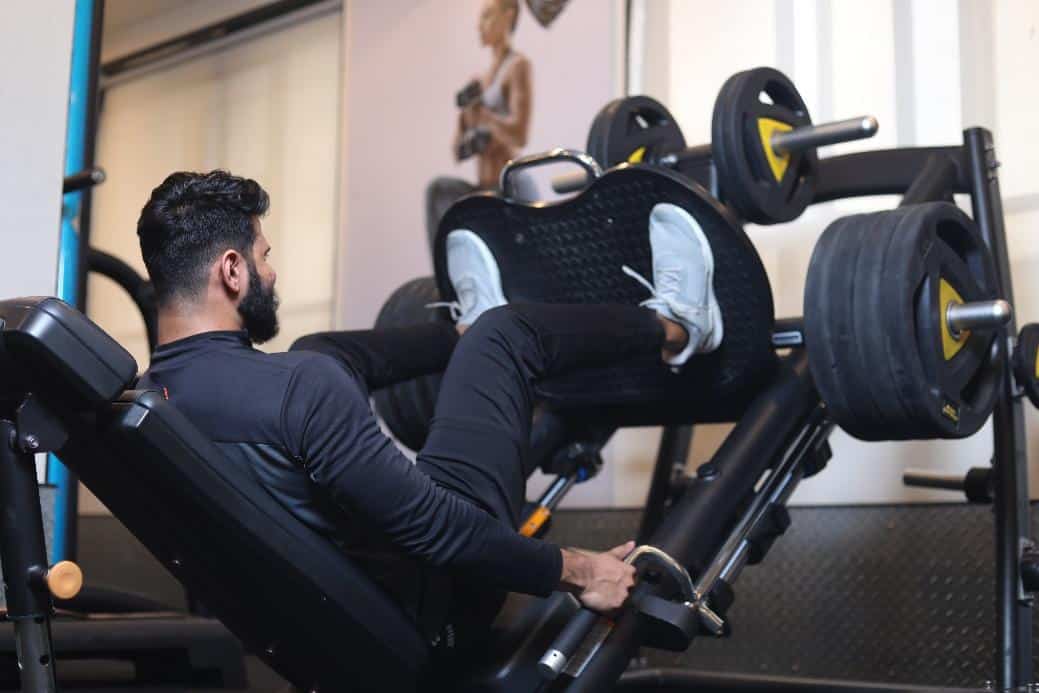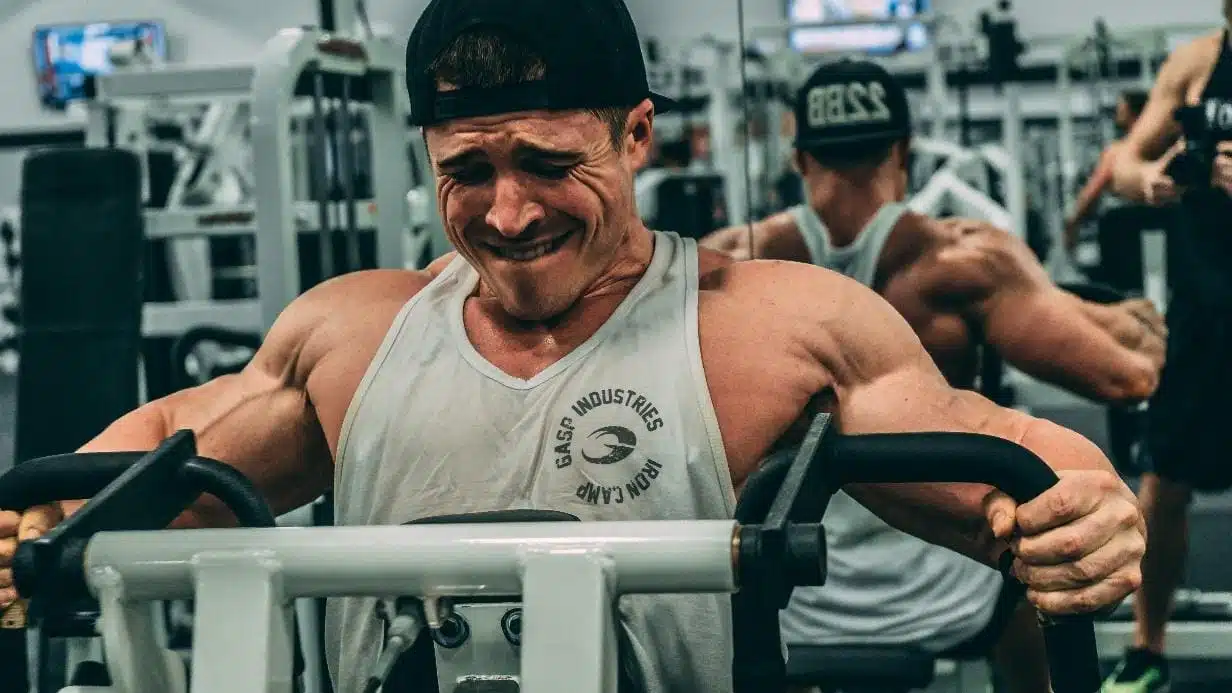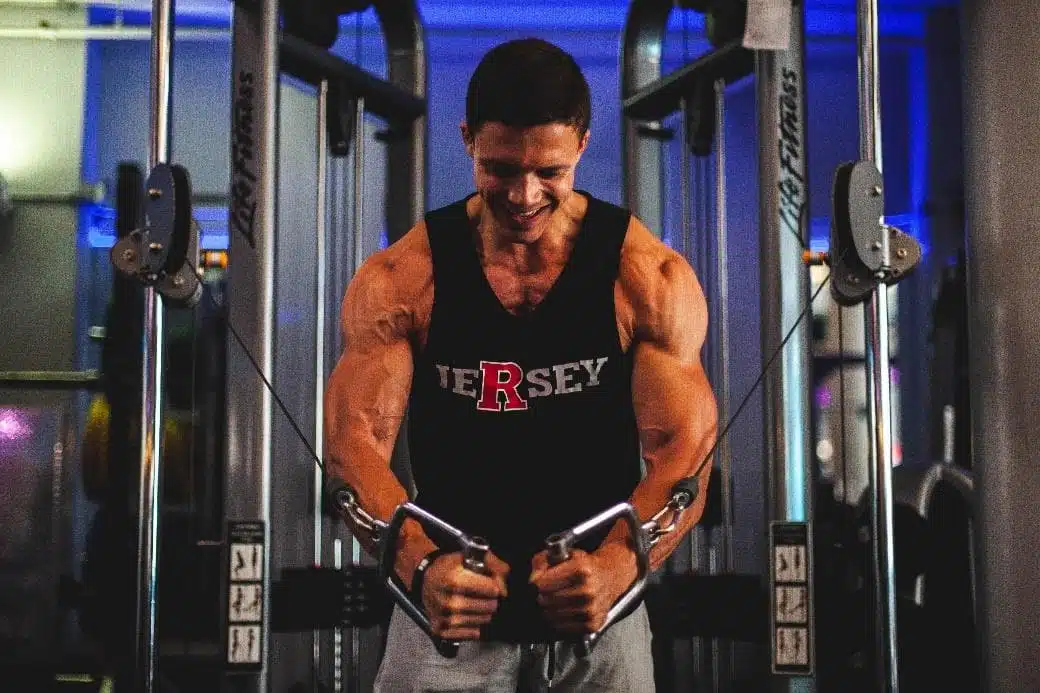16 de November de 2023
Volume vs Intensity for hypertrophy. ¿Do you really need it?
Volume & Intensity – Definitions

Training Volume
The training volume for strength is described as the amount of work done in a given time, measured in repetitions and sets (McBride et al., 2009). It is crucial to consider that when counting sets for muscle hypertrophy, science defines a set as one that is completed with no more than four repetitions from muscular failure (Baz-Valle et al., 2021).
There are sets, like those in warm-ups, where we perform a set of repetitions but fall far from muscular failure. Such sets would not be counted in the scientific volume calculation with the goal of muscle growth. If scientific literature talks about 20 sets per muscle group, it means that all of them have been taken to muscular failure or stopped at most four repetitions from it. This information is essential for truly understanding what we mean when we count a set.
Training Intensity
Training intensity in strength has two aspects: load selection and effort character.
- Load selection is measured as a percentage of one-repetition maximum (%1RM), where 100% of 1RM is the total weight we can lift once. If we can lift 100 kilograms in bench press just once, our 100% of 1RM, or 1RM, will be 100 kilograms. From there, we can lift a percentage of it, for example, 80%, which would be 80 kg, or any other load we choose. To calculate training intensity you can use a 1RM calculator.
- Effort character is a subjective measure that we won’t delve into in this article. The only thing to keep in mind is that when aiming to gain muscle mass, we should perform each set with a high effort character, meaning we go to muscular failure or close to it in each set. There are many nuances when comparing volume vs intensity for hypertrophy, but in this article, we will focus on comparing the number of sets vs the load used in each of them to simplify it as much as possible.
Volume vs Intensity for Hypertrophy: Two Inversely Related Variables

In recent years, the training volume for muscle hypertrophy has received a lot of attention. Some studies support the dose-response hypothesis (Brigatto et al., 2022), while others propose an inverted “U” relationship between training volume and muscle mass gains (Heaselgrave et al., 2019). Both theories are true because, with more volume, there is more muscle hypertrophy (dose-response relationship), but after a certain number of sets per muscle group, it would be counterproductive to add more sets, confirming the inverted “U” shape (Baz-Valle et al., 2022; Schoenfeld, Ogborn, et al., 2017).
Each muscle group may have different dose-response curves for training volume. Muscle groups like the quadriceps tolerate a much higher volume per session than the flexors and extensors of the elbow (Wernbom et al., 2007). One reason is the load that the biceps and triceps receive when training other muscles like the back, chest, or shoulders. When doing pull-ups, we count the sets for the back, but the biceps also exert significant effort in them. When pushing the bar in bench press or military press, the triceps is a synergist in the movement, so those sets should also be counted for that elbow extensor.
The question that many have when comparing volume vs intensity for muscle hypertrophy is whether it is more important to have high volume or high intensity for muscle growth. It is clear that it is not possible to train with both high volume and high intensity at the same time. You can easily visualize it with a practical example: a 100-meter sprint allows you to go at maximum speed for 10 seconds (maximum intensity), but you cannot maintain that speed for a longer time; a marathon (very high volume) allows you to cover 42.195 km without stopping, but the running pace will be infinitely slower than in the 100-meter sprint.
When weight training, the same principle applies, and you’ve likely experienced it in the gym. You start the first exercise feeling fresh, and since you’re not fatigued, you can train intensely. However, after 15 sets, that intensity has decreased significantly, with volume taking its place. The more sets you do in the session, the lower the intensity you can develop in them. That is why we have to choose between volume vs intensity for hypertrophy. Throughout the article, we will explore which of the two is more important, and if we can give almost all importance to one of the two.
Training Volume: The Most Important Variable for Muscle Hypertrophy

Volume is the star player when it comes to muscle hypertrophy (Figueiredo et al., 2018), just as intensity is the predominant variable that modulates muscle strength (Borde et al., 2015). As long as the effort level is high, close to muscular failure, training volume seems to be the most crucial variable for muscle hypertrophy (Baz-Valle et al., 2022; Schoenfeld, Ogborn, et al., 2017). Proximity to muscular failure is essential to achieve optimal stimulation for muscle hypertrophy, regardless of the chosen load and the range of repetitions performed (Dankel et al., 2017; Morton et al., 2019). Therefore, more than the weight lifted, the number of sets for each muscle group taken to or near muscular failure will be the main data point to monitor for muscle mass gain.
A systematic review with meta-analysis compared hypertrophic adaptations achieved with 12-20 weekly sets versus more than 20 weekly sets per muscle group (Baz-Valle et al., 2022). The conclusion is that there is a favorable trend towards high training volume (more than 20 sets per week and muscle group). There are studies with excessively high volumes, even comparing 45 weekly sets with 24 weekly sets per muscle group (Schoenfeld et al., 2019).
The higher-volume group consistently achieved the greatest improvements in all experiments, but many factors can come into play, such as each person’s training status and training frequency. Highly trained individuals and athletes require higher training volumes for muscle growth than untrained individuals (Peterson et al., 2005). Therefore, when comparing volume vs intensity for hypertrophy, the variable we really need is volume, albeit with some nuances that we’ll explore later on.
Does Volume Come Out on Top in the Volume vs. Intensity Showdown?
When high-volume workouts have faced off against high-intensity ones for muscle growth, the high-volume programs have come out on top (Giessing et al., 2016; Vann et al., 2022). The exact mechanism by which higher training volume promotes muscle hypertrophy isn’t completely understood. However, some studies have shown that muscle protein synthesis and intracellular anabolic pathways respond to increased training volume (Burd, Holwerda, et al., 2010; McKendry et al., 2016; Terzis et al., 2010).
For instance, higher training volumes boost both the magnitude and duration of protein synthesis during post-exercise recovery (Burd, Holwerda, et al., 2010). It’s evident that training volume impacts intracellular anabolic muscle processes, which is more than enough reason to prove that volume takes the crown in the volume vs. intensity showdown for hypertrophy.
Why High Volume Wins in the Showdown: Volume vs. Intensity for Hypertrophy

There are numerous studies that have compared how different intensities affect muscle hypertrophy. To keep things simple, scientific literature establishes four intensity ranges: very light load, light load, moderate load, and heavy load (Carvalho et al., 2022).
- Very light load (less than 30% of 1RM or more than 35RM).
- Light load (30% – 59% of 1RM, or 16-35 RM).
- Moderate load (60% – 79% of 1RM, or 8-15RM).
- Heavy load (equal to or more than 80% of 1RM, or equal to or less than 7RM).
Volume seems to be one of the most important, if not the most important, factors influencing muscle hypertrophy, as long as the training has sufficient intensity (Figueiredo et al., 2018). What constitutes sufficient intensity? That’s the eternal question we’re going to address in this article. In “broscience,” as the gym science is known, it’s common to recommend moderate to high loads for muscle hypertrophy. However, training with lower loads or intensities promotes muscle gains similar to higher intensities, as long as we train close to muscular failure (Mangine et al., 2015; Mitchell et al., 2012).
High loads are commonly linked to power gains (strength zone), moderate loads to muscle mass gains (hypertrophy zone), and light loads to power endurance adaptations (muscular endurance zone). However, this implies a reductionist view because other loads outside of these work zones are also necessary to maximize each of them (Schoenfeld, Grgic, et al., 2017).

When comparing volume vs. intensity for hypertrophy to figure out which is more important, there is a clear consensus in current scientific literature: low, moderate, and high loads result in similar increases in muscle growth (Burd, West, et al., 2010; Mitchell et al., 2012). Very light loads (less than 30% of 1RM) should be avoided in muscle hypertrophy training because they don’t achieve the same adaptations, with that 30% of 1RM being the minimum threshold of intensity (Schoenfeld, 2013).
This means that muscle hypertrophy gains are likely similar regardless of the training load (Lopez et al., 2021). Low, moderate, and high loads can be used interchangeably to gain muscle mass, so while intensity is important, it takes a back seat to volume when it comes to muscle growth. Therefore, when aiming to progress in training for muscle mass gain, focus primarily on increasing volume rather than load, as it will provide you with greater hypertrophic adaptations.
Intensity Isn’t as Crucial in Hypertrophy, But…
Theoretically, it’s proven that we can achieve the same hypertrophic adaptations with different loads. However, we can’t ignore the practical side, how people feel when training with light or challenging heavy loads. Light loads at 30% can yield similar results to 80% loads, as long as both sets are taken to muscular failure (Schoenfeld, 2013).
The issue is that reaching muscular failure with 30% of 1RM requires many repetitions, and that kind of training isn’t appealing to most people. On the other hand, the same holds true for heavy loads near the maximum, posing a significant psychological challenge, especially in exercises like squats, bench press, or deadlifts. Therefore, even though similar results can be achieved with different loads, people tend to choose moderate loads for training.
How Can I Add More Volume to My Programs?

Increased volume in power training can be achieved in multiple ways. Within a single session, it can be accomplished by incorporating more repetitions for each counted set, increasing the number of sets per muscle group, and adding more exercises. Throughout the week, training frequency becomes the variable that allows us to accumulate more total volume per muscle group.
Advanced Techniques to Get More Repetitions and Sets per Session
Advanced training techniques have two goals: increasing training volume within the same duration as a traditional session and achieving the same volume in less time than a traditional session (Krzysztofik et al., 2019). Advanced techniques like drop sets, rest-pause, etc., dramatically increase session volume because they allow for many more sets per unit of time.
Advanced techniques don’t directly promote muscle growth; instead, they succeed in increasing training volume, and it’s this volume increase that leads to greater muscle hypertrophy (Goto et al., 2004). When comparing the volume of an advanced technique with the volume of a traditional session, muscle mass gains are the same (Angleri et al., 2017). However, with advanced techniques, you can achieve the same volume in much less time. A recently published systematic review with meta-analysis confirmed that using drop sets achieves the same volume as traditional training in one-third of the time (Sødal et al., 2023), but the muscle mass gains remain the same.
Rest Intervals Affect Session Volume
Rest between sets is another training variable manipulated for muscle growth. A short rest will allow for fewer repetitions in the next set compared to if a slightly longer rest had been taken. The goal is to rest the minimum amount to get the most out of the next set. Although this value is entirely indicative and general, when training with moderate and light loads, a two-minute rest seems to be the “magic number” for maximizing muscle hypertrophy (Grgic et al., 2017).
More Exercises, More Stimulation of All Fibers
When incorporating more sets per muscle group, we have two options: add more sets to the same exercise or include more exercises with fewer sets each. A study compared ten sets of the same exercises in a training program with five sets on those same exercises (Amirthalingam et al., 2017). The researchers indicated that achieving high volume is best accomplished by incorporating different exercises rather than doing a large number of sets of the same exercises. In other words, if you’re planning to do 20 sets, it’s preferable to select 5 or 6 exercises rather than doing those sets with only 2 or 3 exercises.f
Frequency, the Best Friend of Volume
Increasing training frequency along with volume appears to be the most suitable strategy for optimizing muscle growth (Schoenfeld et al., 2019). By training each muscle group more days per week, we can incorporate more quality sets each day. However, it’s essential to consider that giving more volume to one muscle group means taking that volume away from another.
We’ve seen that the best way to enhance muscle mass is by increasing volume, with less emphasis on intensity, as long as we go to or near muscular failure. If we want to improve a specific muscle group, the best strategy is to train it more days per week and distribute a high volume across all those days. This allows us to train with more volume, first because we can include more sets, and second because being more rested each day allows us to do more repetitions per set.
Conclusions
When aiming to progress in training for muscle mass gain, focus on increasing volume rather than load, as it will provide you with greater hypertrophic adaptations. Volume appears to be one of the most important, if not the most important, factors influencing muscle hypertrophy, as long as the training has sufficient intensity.
A higher volume or dose of power training produces more muscle mass gains until reaching a plateau. Beyond this plateau, adding more volume may bring more drawbacks than benefits. This concept is known as an inverted “U” shaped curve and is supported by current scientific literature. The challenge lies in not knowing where that plateau is, as it depends on various factors and is a different threshold for each individual and muscle group.
Intensity is a fundamental variable in training, but if understood as the lifted load, it’s not as crucial as volume for gaining muscle mass. Various studies have shown that hypertrophic adaptations can be achieved with similar outcomes using loads of 30% of 1RM compared to loads of 80% of 1RM. This is why we should seek ways to increase volume, such as using advanced techniques or increasing training frequency, to maximize muscle growth, rather than solely focusing on lifting heavier weights in exercises, although that too is another form of progressive overload that can lead to muscle mass improvement.
References
Amirthalingam, T., Mavros, Y., Wilson, G. C., Clarke, J. L., Mitchell, L., & Hackett, D. A. (2017). Effects of a modified German volume training program on muscular hypertrophy and strength. Journal of Strength and Conditioning Research, 31(11), 3109–3119. https://doi.org/10.1519/JSC.0000000000001747
Angleri, V., Ugrinowitsch, C., & Libardi, C. A. (2017). Crescent pyramid and drop-set systems do not promote greater power gains, muscle hypertrophy, and changes on muscle architecture compared with traditional resistance training in well-trained men. European Journal of Applied Physiology, 117(2), 359–369. https://doi.org/10.1007/S00421-016-3529-1
Baz-Valle, E., Balsalobre-Fernández, C., Alix-Fages, C., & Santos-Concejero, J. (2022). A Systematic Review of The Effects of Different Resistance Training Volumes on Muscle Hypertrophy. Journal of Human Kinetics, 81(1), 199. https://doi.org/10.2478/HUKIN-2022-0017
Baz-Valle, E., Fontes-Villalba, M., & Santos-Concejero, J. (2021). Total Number of Sets as a Training Volume Quantification Method for Muscle Hypertrophy: A Systematic Review. Journal of Strength and Conditioning Research, 35(3), 870–878. https://doi.org/10.1519/JSC.0000000000002776
Borde, R., Hortobágyi, T., & Granacher, U. (2015). Dose-Response Relationships of Resistance Training in Healthy Old Adults: A Systematic Review and Meta-Analysis. Sports Medicine (Auckland, N.Z.), 45(12), 1693–1720. https://doi.org/10.1007/S40279-015-0385-9
Brigatto, F. A., de Medeiros Lima, L. E., Germano, M. D., Aoki, M. S., Braz, T. V., & Lopes, C. R. (2022). High Resistance-Training Volume Enhances Muscle Thickness in Resistance-Trained Men. Journal of Strength and Conditioning Research, 36(1), 22–30. https://doi.org/10.1519/JSC.0000000000003413
Burd, N. A., Holwerda, A. M., Selby, K. C., West, D. W. D., Staples, A. W., Cain, N. E., Cashaback, J. G. A., Potvin, J. R., Baker, S. K., & Phillips, S. M. (2010). Resistance exercise volume affects myofibrillar protein synthesis and anabolic signalling molecule phosphorylation in young men. The Journal of Physiology, 588(Pt 16), 3119–3130. https://doi.org/10.1113/JPHYSIOL.2010.192856
Burd, N. A., West, D. W. D., Staples, A. W., Atherton, P. J., Baker, J. M., Moore, D. R., Holwerda, A. M., Parise, G., Rennie, M. J., Baker, S. K., & Phillips, S. M. (2010). Low-load high volume resistance exercise stimulates muscle protein synthesis more than high-load low volume resistance exercise in young men. PloS One, 5(8). https://doi.org/10.1371/JOURNAL.PONE.0012033
Carvalho, L., Junior, R. M., Barreira, J., Schoenfeld, B. J., Orazem, J., & Barroso, R. (2022). Muscle hypertrophy and power gains after resistance training with different volume-matched loads: a systematic review and meta-analysis. Applied Physiology, Nutrition, and Metabolism = Physiologie Appliquee, Nutrition et Metabolisme, 47(4), 357–368. https://doi.org/10.1139/APNM-2021-0515
Dankel, S. J., Mattocks, K. T., Jessee, M. B., Buckner, S. L., Mouser, J. G., & Loenneke, J. P. (2017). Do metabolites that are produced during resistance exercise enhance muscle hypertrophy? European Journal of Applied Physiology, 117(11), 2125–2135. https://doi.org/10.1007/S00421-017-3690-1
Figueiredo, V. C., de Salles, B. F., & Trajano, G. S. (2018). Volume for Muscle Hypertrophy and Health Outcomes: The Most Effective Variable in Resistance Training. Sports Medicine (Auckland, N.Z.), 48(3), 499–505. https://doi.org/10.1007/S40279-017-0793-0
Giessing, J., Eichmann, B., Steele, J., & Fisher, J. (2016). A comparison of low volume “high-intensity-training” and high volume traditional resistance training methods on muscular performance, body composition, and subjective assessments of training. Biology of Sport, 33(3), 241–249. https://doi.org/10.5604/20831862.1201813
Goto, K., Nagasawa, M., Yanagisawa, O., Kizuka, T., Ishii, N., & Takamatsu, K. (2004). Muscular adaptations to combinations of high- and low-intensity resistance exercises. Journal of Strength and Conditioning Research, 18(4), 730–737. https://doi.org/10.1519/R-13603.1
Grgic, J., Lazinica, B., Mikulic, P., Krieger, J. W., & Schoenfeld, B. J. (2017). The effects of short versus long inter-set rest intervals in resistance training on measures of muscle hypertrophy: A systematic review. European Journal of Sport Science, 17(8), 983–993. https://doi.org/10.1080/17461391.2017.1340524
Heaselgrave, S. R., Blacker, J., Smeuninx, B., McKendry, J., & Breen, L. (2019). Dose-Response Relationship of Weekly Resistance-Training Volume and Frequency on Muscular Adaptations in Trained Men. International Journal of Sports Physiology and Performance, 14(3), 360–368. https://doi.org/10.1123/IJSPP.2018-0427
Krzysztofik, M., Wilk, M., Wojdała, G., & Gołaś, A. (2019). Maximizing Muscle Hypertrophy: A Systematic Review of Advanced Resistance Training Techniques and Methods. International Journal of Environmental Research and Public Health, 16(24). https://doi.org/10.3390/IJERPH16244897
Lopez, P., Radaelli, R., Taaffe, D. R., Newton, R. U., Galvão, D. A., Trajano, G. S., Teodoro, J. L., Kraemer, W. J., Häkkinen, K., & Pinto, R. S. (2021). Resistance Training Load Effects on Muscle Hypertrophy and Strength Gain: Systematic Review and Network Meta-analysis. Medicine and Science in Sports and Exercise, 53(6), 1206. https://doi.org/10.1249/MSS.0000000000002585
Mangine, G. T., Hoffman, J. R., Gonzalez, A. M., Townsend, J. R., Wells, A. J., Jajtner, A. R., Beyer, K. S., Boone, C. H., Miramonti, A. A., Wang, R., LaMonica, M. B., Fukuda, D. H., Ratamess, N. A., & Stout, J. R. (2015). The effect of training volume and intensity on improvements in muscular strength and size in resistance-trained men. Physiological Reports, 3(8). https://doi.org/10.14814/PHY2.12472
Mcbride, J. M., Mccaulley, G. O., Cormie, P., Nuzzo, J. L., Cavill, M. J., & Triplett, N. T. (2009). Comparison of methods to quantify volume during resistance exercise. Journal of Strength and Conditioning Research, 23(1), 106–110. https://doi.org/10.1519/JSC.0B013E31818EFDFE
McKendry, J., Pérez-López, A., McLeod, M., Luo, D., Dent, J. R., Smeuninx, B., Yu, J., Taylor, A. E., Philp, A., & Breen, L. (2016). Short inter-set rest blunts resistance exercise-induced increases in myofibrillar protein synthesis and intracellular signalling in young males. Experimental Physiology, 101(7), 866–882. https://doi.org/10.1113/EP085647
Mitchell, C. J., Churchward-Venne, T. A., West, D. W. D., Burd, N. A., Breen, L., Baker, S. K., & Phillips, S. M. (2012). Resistance exercise load does not determine training-mediated hypertrophic gains in young men. Journal of Applied Physiology, 113(1), 71. https://doi.org/10.1152/JAPPLPHYSIOL.00307.2012
Morton, R. W., Sonne, M. W., Farias Zuniga, A., Mohammad, I. Y. Z., Jones, A., McGlory, C., Keir, P. J., Potvin, J. R., & Phillips, S. M. (2019). Muscle fibre activation is unaffected by load and repetition duration when resistance exercise is performed to task failure. The Journal of Physiology, 597(17), 4601–4613. https://doi.org/10.1113/JP278056
Peterson, M. D., Rhea, M. R., & Alvar, B. A. (2005). Applications of the dose-response for muscular strength development: a review of meta-analytic efficacy and reliability for designing training prescription. Journal of Strength and Conditioning Research, 19(4), 950–958. https://doi.org/10.1519/R-16874.1
Schoenfeld, B. J. (2013). Is there a minimum intensity threshold for resistance training-induced hypertrophic adaptations? Sports Medicine (Auckland, N.Z.), 43(12), 1279–1288. https://doi.org/10.1007/S40279-013-0088-Z
Schoenfeld, B. J., Contreras, B., Krieger, J., Grgic, J., Delcastillo, K., Belliard, R., & Alto, A. (2019). Resistance Training Volume Enhances Muscle Hypertrophy but Not Strength in Trained Men. Medicine and Science in Sports and Exercise, 51(1), 94–103. https://doi.org/10.1249/MSS.0000000000001764
Schoenfeld, B. J., Grgic, J., Ogborn, D., & Krieger, J. W. (2017). Strength and Hypertrophy Adaptations Between Low- vs. High-Load Resistance Training: A Systematic Review and Meta-analysis. Journal of Strength and Conditioning Research, 31(12), 3508–3523. https://doi.org/10.1519/JSC.0000000000002200
Schoenfeld, B. J., Grgic, J., Van Every, D. W., & Plotkin, D. L. (2021). Loading Recommendations for Muscle Strength, Hypertrophy, and Local Endurance: A Re-Examination of the Repetition Continuum. Sports 2021, Vol. 9, Page 32, 9(2), 32. https://doi.org/10.3390/SPORTS9020032
Schoenfeld, B. J., Ogborn, D., & Krieger, J. W. (2017). Dose-response relationship between weekly resistance training volume and increases in muscle mass: A systematic review and meta-analysis. Journal of Sports Sciences, 35(11), 1073–1082. https://doi.org/10.1080/02640414.2016.1210197
Sødal, L. K., Kristiansen, E., Larsen, S., & van den Tillaar, R. (2023). Effects of Drop Sets on Skeletal Muscle Hypertrophy: A Systematic Review and Meta-analysis. Sports Medicine – Open, 9(1). https://doi.org/10.1186/S40798-023-00620-5
Terzis, G., Spengos, K., Mascher, H., Georgiadis, G., Manta, P., & Blomstrand, E. (2010). The degree of p70 S6k and S6 phosphorylation in human skeletal muscle in response to resistance exercise depends on the training volume. European Journal of Applied Physiology, 110(4), 835–843. https://doi.org/10.1007/S00421-010-1527-2
Vann, C. G., Sexton, C. L., Osburn, S. C., Smith, M. A., Haun, C. T., Rumbley, M. N., Mumford, P. W., Montgomery, N. T., Ruple, B. A., McKendry, J., Mcleod, J., Bashir, A., Beyers, R. J., Brook, M. S., Smith, K., Atherton, P. J., Beck, D. T., McDonald, J. R., Young, K. C., … Roberts, M. D. (2022). Effects of High-Volume Versus High-Load Resistance Training on Skeletal Muscle Growth and Molecular Adaptations. Frontiers in Physiology, 13. https://doi.org/10.3389/FPHYS.2022.857555
Wernbom, M., Augustsson, J., & Thomeé, R. (2007). The influence of frequency, intensity, volume and mode of power training on whole muscle cross-sectional area in humans. Sports Medicine (Auckland, N.Z.), 37(3), 225–264. https://doi.org/10.2165/00007256-200737030-00004

